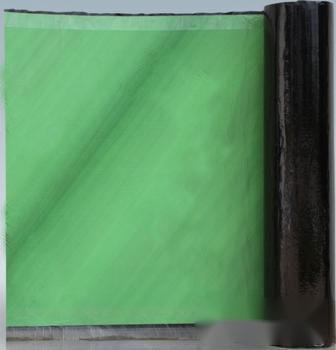One, Product Introduction:
The high polymer wet-laid waterproof membrane bonded by strong cross film reaction has excellent physical properties, thermal dimensional stability, UV resistance, and bidirectional tear resistance.
Triple skin waterproof concept
Strong cross film (heavy waterproof)
The strong cross laminated film is a multi-layer composite film formed by laminating multiple layers of high-density polyethylene film at a certain angle. It overcomes the shortcomings of ordinary high-density polyethylene film such as easy tearing and unstable thermal scale, and has the advantages of high tensile strength, good elongation, tear resistance, puncture resistance, UV resistance, and good impact performance.
Comparison conclusion: Ordinary film is prone to tearing while cross film has excellent tear strength.
Infiltration reaction adhesive layer (second waterproof)
There are mainly three types of bonding forces between the common waterproof layer and the building waterproof surface:
1. Electrostatic theory: A double electric layer is formed at the interface between the adhesive layer and the adherend due to static electricity generating attraction.
2. Adsorption theory: The forces between molecules such as hydrogen bonds, van der Waals forces, and other chemical interactions.
3. Mechanical theory: There are voids on the surface of solid materials, the adhesive flows, diffuses, and penetrates into the surface of the adherend, connecting the adherend to each other through mutual engagement.
4. Chemical bond mechanism: The chemical bond force is the strong force of interfacial bonding, which can produce high-strength bonding force. Ordinary waterproof membranes bond with concrete only through the first and second mechanisms. Infiltration reaction adhesive waterproof materials combine the fourth force - chemical bond action force.
Infiltration reaction sealing layer (third waterproof)
The infiltration reaction adhesive layer reacts physically and chemically with concrete to form an irreversible sealing layer, making the infiltration reaction adhesive membrane have both the waterproof effect of a waterproof membrane and the waterproof effect of a waterproof coating.
Two, Product Features:
Bonding strength: The active components of the adhesive layer can undergo chemical cross-linking reactions with the silicate in concrete, forming a triple skin waterproof effect under the dual action of physical and chemical effects.
Excellent impact and puncture resistance: The strong cross laminated film has strong toughness to resist external impact and damage.
Excellent elasticity and tensile strength: It has excellent resistance to deformation and tensile strength.
Excellent low-temperature performance: It can adapt to different seasons and the influence of different regional climates.
Good dimensional stability, no wrinkling with temperature changes.
Self-healing function: The infiltration reaction adhesive layer has good creep resistance, providing good coverage for sharp objects, and can automatically seal and heal minor damage and cracks during construction.
Three, Construction methods and procedures
The strong cross laminated film reaction bonded high polymer wet-laid waterproof membrane should be constructed using the wet-laid method, directly bonded and sealed with cement adhesive layer.
1. Substrate treatment: The substrate should be flat, free of oil stains, free of obvious water, can be moist, dry substrates need to be moistened with water; the internal and external angles should be made into arc shapes; when laying, apply base treatment agent.
2. Cement adhesive preparation: Use no less than 32.5R ordinary silicate cement mixed with an appropriate amount of water to form a thick paste, generally with a water-cement ratio of 0.4, pour the cement into water to soak, mix with an electric mixer for 1-2 minutes, mix and let stand for about 5 minutes for later use.
3. Node treatment: Self-adhesive membranes, double-sided self-adhesive tapes, and seam-matched sealants can be used for sealing.
4. Apply cement adhesive, when scraping and applying the cement adhesive, it should be as uniform and consistent as possible, generally apply about 2mm, scrape the cement adhesive while laying the membrane, and use a roller for firm bonding.
5. Self-inspection, acceptance.
Substrate cleaning, moistening -> Cement adhesive preparation -> Node treatment -> Apply cement adhesive -> Laying membrane over a large area -> Rolling to bond -> Seal the ends -> Self-inspection, acceptance
Four, Application scope
1. Various industrial and civil building basements, floors, tunnels, bridges, reservoirs.
2. Waterproofing projects, subways, green roofs and other engineering waterproofing.
Guangzhou Hongniu Building Waterproof Material Co., Ltd.









